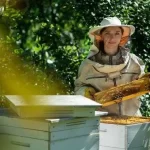Toddler Tells Mom She Hears Monsters in Her Bedroom. Beekeeper Discovers Over 50,000 Bees in the Wall
The post Toddler Tells Mom She Hears Monsters in Her Bedroom. Beekeeper Discovers Over 50,000 Bees in the Wall appeared first on Healthy Holistic Living.
In a story that sounds like it’s straight out of a children’s fairytale with a twist of real-life horror, a young toddler’s complaints of hearing “monsters” in her room led to a shocking discovery in a century-old farmhouse. Ashley Massis Class, who shares snippets of her life on TikTok, was initially dismissive of her daughter’s claims, attributing them to a vivid imagination fueled by movies like “Monster’s Inc.” However, the persistent cries of her child unveiled a hidden world buzzing within the walls of their home, leading to a scenario no one could have predicted.
The Class family’s old farmhouse, cherished for its rustic charm, was harboring a secret in its ancient walls. After noticing a few bees casually entering their attic, Ashley and her husband decided to investigate further, thinking it was a minor issue. Little did they know, this decision would unfold a tale of nature’s persistence and a beekeeper’s daring rescue mission, revealing over 50,000 bees and a massive honeycomb hidden within the walls. This discovery not only solved the mystery of the “monsters” but also brought to light the delicate balance between human habitation and wildlife conservation.
A Startling Discovery
The unsettling episodes of night terrors reported by Ashley’s daughter became increasingly severe, disrupting the peace of their household. Initially dismissing these incidents as a child’s typical fear of the dark or perhaps a side effect of having recently welcomed a new sibling, Ashley tried to console her with humor and homemade “monster spray.” Yet, the child’s insistence that the sounds were emanating from within the walls prompted a more serious investigation. This concern coincided with Ashley noticing bees sporadically entering their attic, an observation that set the stage for an unforeseen revelation.
With the farmhouse being a century old, the couple was aware of its quirks and possible maintenance challenges but did not anticipate hosting an entire colony of bees. Upon contacting pest control, they were informed that these were not just any bees, but endangered honeybees, which required a preservation rather than extermination approach. This new information led them down a path of environmental responsibility, compelling them to seek the expertise of a professional beekeeper instead of conventional pest exterminators.
The beekeeper’s initial inspections were uneventful, dismissing the presence of bees inside the living spaces. However, the breakthrough came when he decided to observe more closely. Using a thermal camera, he traced the bees’ path to a section directly above the toddler’s room. The situation escalated quickly when, upon drilling into the wall, a scene straight out of a horror movie unfolded. The wall not only housed bees but was oozing dark, honey-like substance, turning the nightmare of monsters in the walls into a stark reality.
An Unprecedented Hive
The discovery of the hive was nothing short of cinematic, with bees swarming out in massive numbers the moment the beekeeper breached the wall. The dark honey oozed down the walls, mimicking a scene from a thriller, which was both terrifying and fascinating. This revelation was not just about uncovering a hidden natural habitat but also about the resilience and adaptability of nature, as the bees had constructed one of the largest hives the beekeeper had seen in his four decades of experience. The initial removal process involved extracting a staggering 20,000 bees and a hundred-pound chunk of honeycomb on the first day, a task that proved both delicate and urgent.
As the beekeeper continued his efforts, the complexity of the situation became apparent. The wall, a vital structural element of the house, now required significant reconstruction to ensure both the safety of the inhabitants and the preservation of architectural integrity. The bees had ingeniously exploited a small entry point to create a thriving colony, which now posed a considerable challenge in terms of removal and repair. The family faced an unexpected financial burden, as the removal process, coupled with the necessary repairs and cleanup of honey-soaked structures, was estimated to be around $20,000.
Throughout this ordeal, the importance of handling such situations with sensitivity to wildlife was underscored. The beekeeper, adept in his field, managed not only to remove the bees safely but also to relocate the queen bee and her colony to a sanctuary, ensuring their survival. This act of conservation was a poignant reminder of the delicate balance between human life and nature, emphasizing the need for coexistence and respect for all living creatures, no matter how small.
Practical Tips for Homeowners Facing Wildlife Intrusions
Dealing with unexpected wildlife in residential areas can be daunting. Here are some practical tips for homeowners who might find themselves in similar situations:
Identify Entry Points: Regularly inspect your home for any cracks, holes, or other potential entry points for wildlife. Even small openings can be gateways for animals seeking shelter.
Example: Check areas around windows, doors, and the roofline, which are common access points.
Engage Professionals Early: If you suspect the presence of wildlife, consult with professionals promptly. Pest control experts and wildlife removal specialists can offer solutions that are both effective and humane.
Example: Early intervention by a beekeeper in the case of bees can prevent larger infestations.
Use Preventive Measures: Implement preventative strategies to deter wildlife from entering your home.
Example: Use sealants to close off entry points and trim trees or bushes close to your house that may provide access to your roof or windows.
Educate Your Family: Teach family members, especially children, about the wildlife in your area. Understanding how to coexist safely with different species can prevent panic and harm.
Example: Explain the importance of not disturbing bees or other wildlife, as these creatures are generally non-aggressive unless threatened.
Prepare for Emergencies: Have a plan in place for dealing with wildlife emergencies. This includes having contact information for local wildlife removal services and knowing first aid for animal bites or stings.
Example: Keep a first aid kit accessible and educate your family on its use in case of stings or other wildlife-related injuries.
These tips can help homeowners manage wildlife encounters responsibly and safely, ensuring that both human and animal residents can coexist peacefully.
The Role of Wildlife in Urban and Rural Settings
The encounter with the bee colony in the Class family’s home serves as a poignant reminder of the significant role wildlife plays in both urban and rural environments. As human settlements expand, interactions between wildlife and residents become more frequent, often leading to conflicts. However, these encounters also provide valuable opportunities to learn about and contribute to biodiversity conservation. Here’s how wildlife benefits our environments:
Pollination: Many wildlife species, especially bees, play a crucial role in pollinating plants. This not only supports local flora but also aids in food production, as many crops depend on pollination to bear fruit.
Biodiversity: The presence of diverse wildlife species contributes to a robust ecosystem. Each species plays a unique role, contributing to the health and stability of their environments.
Natural Pest Control: Many animals, such as birds and bats, help control pest populations naturally. This reduces the need for chemical pesticides, which can be harmful to the environment and human health.
Educational Opportunities: Wildlife encounters provide unique learning opportunities, especially for children. They can spark interest in biology and environmental science, promoting a lifelong respect and curiosity for nature.
Mental Health Benefits: Studies have shown that interactions with nature and wildlife can improve mental health, reducing stress and enhancing overall well-being.
Understanding the ecological benefits and the necessity of wildlife can encourage communities to adopt more wildlife-friendly practices, such as creating green spaces that accommodate both human and animal needs. This balanced approach can lead to more sustainable coexistence, enriching both our environments and our lives.
Conservation Efforts and Community Engagement
The surprising discovery of a massive bee colony within the walls of a residential home underscores the importance of wildlife conservation and the role that every individual and community can play in supporting these efforts. Engaging with and supporting conservation initiatives not only helps protect endangered species like honeybees but also promotes a healthier, more sustainable environment for everyone. Here are some ways communities and individuals can get involved:
Support Local Conservation Programs: Participating in or donating to local wildlife conservation programs can make a significant impact. These programs often focus on habitat restoration, wildlife protection, and education.
Create Wildlife-Friendly Spaces: Homeowners can contribute to wildlife conservation by creating gardens or spaces that are friendly to local fauna. Planting native plants and providing shelters can attract and protect various wildlife species.
Educate and Advocate: Education is a powerful tool in conservation. By learning about local wildlife and the challenges they face, individuals can become advocates for their protection. Hosting community talks or school programs can spread awareness and foster a community-wide commitment to conservation.
Volunteer: Many conservation efforts rely on volunteers for activities ranging from field work to educational outreach. Volunteering can provide hands-on experience with conservation strategies and direct engagement with wildlife.
Responsible Interaction: Understanding how to interact with wildlife responsibly can prevent harm to both animals and humans. This includes keeping a safe distance, not feeding wild animals, and knowing what to do if you find injured wildlife.
By integrating these practices into daily life and community planning, individuals and communities not only aid in the survival of species like honeybees but also enhance their own living environments. This collaborative approach to conservation creates a ripple effect, improving ecological health and community well-being.
A New Perspective on ‘Monsters’
The ordeal that began with a toddler’s fear of “monsters” in her bedroom evolved into a complex journey of discovery, challenge, and education for the Class family. This experience not only addressed an immediate problem but also opened their eyes to the broader implications of living in harmony with nature. It highlighted the unseen connections between our daily lives and the natural world, emphasizing the importance of awareness and proactive engagement in environmental stewardship.
As the family moves forward, the story of the bees in the wall remains a powerful narrative about the unexpected lessons life can throw our way. It serves as a reminder that sometimes, the monsters are not what they seem, and that with curiosity and courage, we can transform fear into understanding and adversity into opportunity. For the Class family, and for all of us, these encounters can redefine our relationship with the natural world, prompting us to consider more deeply our role in its preservation and the legacy we leave for future generations.
The post Toddler Tells Mom She Hears Monsters in Her Bedroom. Beekeeper Discovers Over 50,000 Bees in the Wall appeared first on Healthy Holistic Living.












